George Dury
Friedrich Julius Georg Dury (1817–1894) was a well-regarded portrait artist who worked in both oil and pastel. Born in Würzburg, Bavaria, he emigrated to the United States in 1849, and became a bespoke gallery artist in Nashville, Tennessee.
Friedrich Julius Georg Dury | |
|---|---|
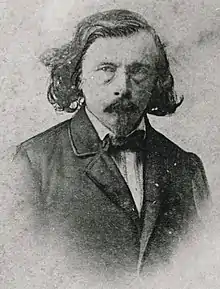 Self-portrait, ca.1860 | |
| Born | March 15, 1817 Würzburg, Kingdom of Bavaria |
| Died | December 2, 1894 (aged 77) Nashville, Tennessee, U.S. |
| Resting place | Mount Olivet Cemetery, Nashville |
| Nationality | Bavarian |
| Known for | Portrait painting |
Notable work | Sarah Polk's White House Portrait. Portrait of Lola Montez |
| Patron(s) | Ludwig I of Bavaria |
An 1870 review said Dury was an artist "who has caught his inspiration from the old masters".[1] Dury typically did not sign his paintings. Dury's work is on display in the US White House, the Cheekwood Botanical Garden and Museum of Art and the Tennessee State Museum.
Early life and education
George Dury was born in Würzburg in the Kingdom of Bavaria in 1817, the first of Nicholas and Augusta (née Lommler) Dury's three children. Showing early talent, Dury was admitted as an art student at the age of 13 at the Academy of Fine Arts Vienna (Akademie der bildenden Künste Wien) in Munich.[2] He graduated eight years later at the age of 21.
Early artistic acclaim
While a student at the Academy of Fine Arts Vienna, Dury developed a technique of using encaustic painting that closely resembled the then highly popular portraiture on ivory. Miniature paintings on ivory are particularly vulnerable due to fading from sunlight and ivory's ability to absorb contaminants. Dury's novel technique was hailed as "widely superior to ivory pictures and even more durable than oil-paintings".[3]
Using his new technique, Dury became known for his talent in painting small cabinet portraits, including his paintings of Prince Adalbert of Bavaria and Queen Consort Therese of Saxe-Hildburghausen. [4][5]
Early European career
King Ludwig I of Bavaria, became Dury's patron, hiring Dury as court painter and charged Dury to paint Ludwig I's Irish-born mistress Eliza Gilbert (better known by her stage name Lola Montez). Dury brought a copy of the painting of Gilbert with him when he emigrated to the US.[2][5] Dury also painted a miniature of Grand Duke Alexei Alexandrovich of Russia.
Later career in America
Dury emigrated to the United States in 1849,[6][7] with his 19-year old fiancée Katherine Schaeffer, his sister Josephine and her fiancé Augustin Gattinger. Both couples were married April 24, 1849 at the American consulate in Le Havre, France before sailing to America.[8]

Arriving in New York City, they took a train to the "end of the line", Dalton, Georgia and a stagecoach from there to Chattanooga, Tennessee, where Dury first settled in Wartburg, Morgan County, Tennessee, and quickly relocated to Nashville, Tennessee in 1850. Initially Dury taught oil painting at the Nashville Female Academy.[9] Dury also set up a second story studio at No. 43 Union Street, accepting commissions as a portrait artist.[10][6][7][11]
US Civil War disruption
Dury lost his job teaching at the Nashville Female Academy when it closed at the beginning of the US Civil War. The Dury family home was often a target for Union soldiers who occupied Nashville for three years. Soldiers "regularly raided the kitchen - stripping hot bread from the oven and taking milk from the children". The Union army billeted soldiers in the Dury home where one soldier died of typhoid fever in Mrs. Dury's arms, thinking she was his mother.[2]
Nevertheless, Dury continued to paint portraits of both Union and Confederate officers during the Civil War, including Gen. Robert E. Lee. It is thought Dury painted the portrait from a sculpture Dury made of Lee. The Lee portrait is in a private collection in Virginia. A smaller copy painted by Dury hangs in Lee's Washington D.C. home "Arlington".[2]
State of Tennessee commission
In May, 1866, the Tennessee state legislature passed a resolution to pay Dury a $ 1,000 commission for a portrait of Gen. George H. Thomas, commander of Union forces during the Battle of Nashville. The state legislature later commissioned Dury to paint portraits of presidents Abraham Lincoln and Andrew Johnson.
Nashville's "Academy of Fine Arts"
In 1872, Dury met with professional "artists and amateurs" in the studio of artist Robert Loftin Newman, where he joined fellow artists who were trying "to establish an Academy of Fine Arts for the purpose of... advancing the cause of art in our midst" in Nashville. Dury was elected vice-president during the meeting. Plans were discussed to purchase and display copies of important European works of art, including statues and paintings.[12]
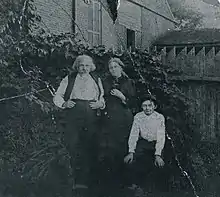
List of Dury portrait subjects
Many Dury's early and most important portraits were donated to the Tennessee State Museum by his grandson Robert Dury of Melbourne Beach, Florida.[2] Dury's portraits of William Walker and Lola Montez are in the Tennessee State Museum.[14][15][16][17] He also painted James D. Porter,[18] Robert Armstrong,[19] William Gannaway Brownlow,[20] Andrew Johnson,[21] Queen Consort Therese of Saxe-Hildburghausen,[22] and William Brimage Bate.[23] A portrait of Randal William McGavock is also attributed to him.[24]
Dury portraits of Sarah Childress Polk
In 1878, during a conversation in Dansville, New York, it was noted the White House did not have a portrait of President Polk's wife Sarah Childress Polk. Frances Willard, national president of Woman's Christian Temperance Union, created a committee, empowering it to commission Dury to paint a life portrait of Mrs. Polk who was seventy-five years old when she sat for the artist.[25]
Dury completed another portrait of Sarah Childress Polk in 1883, 34 years after President Polk's term ended. Dury modeled his oil on canvas portrait after George P. A. Healy's 1846 portrait of Mrs. Polk. Dury's painting hangs in the East Wing of the US White House.[26][27]
Death and burial
Dury died of "old age", December 2, 1894 at the home of his daughter Augusta Brengelman at 711 Russell Street in Nashville, Tennessee.[4] His body was buried at Mount Olivet Cemetery in Nashville.[6][7][28]
Gallery
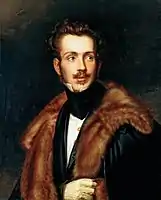
D. Augusto, Duke of Leuchtenberg, circa 1835, oil painting on canvas, 72.2 x 58 cm (28 1/3 x 22.1825 in.), collection of The National Portrait Gallery, The Smithsonian Institution 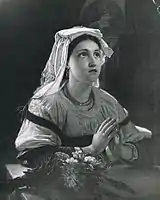
Italian Girl at Prayer, circa 1848, oil painting, 0 × 0 cm (0 x 0 in.), collection of Tennessee State Library and Archives 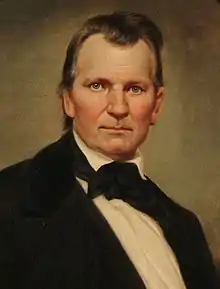
Daniel Smith Donelson, circa 1850, oil painting, 34.9 x 41 cm (13.7 x 16.2 in.), collection of Historic Rock Castle, Hendersonville, 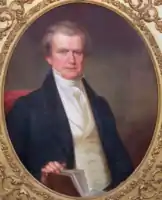
Attorney General Felix Grundy, 1858, oil painting, 85.1 x 67.9cm (33 1/2 x 26 3/4" in.), collection of The National Portrait Gallery, Smithsonian Institution 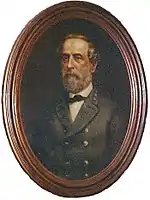
Robert E. Lee, circa 1865, oil painting, 68.58 x 53.54cm (27 x 21 in.), Private collection 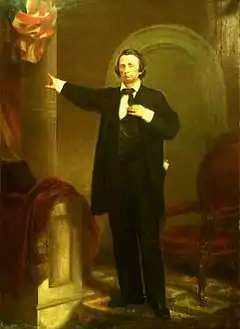
William Brownlow, Tennessee, circa 1866, oil painting, collection of Tennessee State Library and Archives 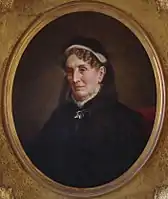
Sarah Childress Polk (at age 75), 1878, oil painting, James K. Polk Ancestral Home Collection, Columbia, Tennessee 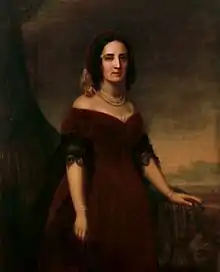
Mrs. James K. Polk, 1883, oil painting, 127.6 x 102.2cm (50.2 x 40.2 in.) 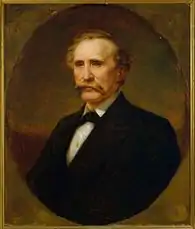
William Brimage Bate, circa 1894, oil painting, 75 x 62.3cm (29 1/2 x 24 1/2 in.), collection of Tennessee State Library and Archives
Exhibitions
1886; Solo exhibit - Tennessee Historical Society at Watkins Institute, Nashville, Tennessee[29]
References
| Wikimedia Commons has media related to George Dury. |
- "A Fine Work of Art". The Nashville Union and American. Nashville, Tennessee. July 7, 1870. p. 1. Retrieved November 4, 2020 – via Newspapers.com.
- "Portraits Tell Artist's Life from Munich to Nashville". The Tennessean. August 9, 1981. p. 8. Retrieved November 6, 2020 – via Newspapers.com.
- Mahoney, Nell Savage (March 4, 1951). "Portraits of the Past: the Artist". The Nashville Tennessean Magazine. Nashville, Tennessee. p. 24. Retrieved November 9, 2020 – via Newspapers.com.
- "George Dury". Retrieved November 5, 2020.
- Tennessee Portrait Project: George Dury. Tennessee State Museum. Accessed February 2018.
- "Mr. Geo. Dury Dead. Well-Known Artist Passes Away in His 78th Year". The Nashville American. December 3, 1894. p. 8. Retrieved May 31, 2018 – via Newspapers.com.
- "Portrait Painter Dead. George Dury Expires After Suffering Six Years From Paralysis". The Courier-Journal. Louisville, Kentucky. December 3, 1894. p. 1. Retrieved May 31, 2018 – via Newspapers.com.
- Huddleston, Ed. "Dury Biography". Tennessee Portrait Project. Tennessee Fine Arts Center, Cheekwood.
- "Dury's - 137 years of service, and still going". Nashville Public Library. Retrieved November 4, 2020.
- "To The Public". The Nashville Tennessean. Nashville, Tennessee. October 7, 1874. p. 4. Retrieved November 4, 2020 – via Newspapers.com.
- "Tennessee State Library and Archives: Photograph and Image Search". tnsos.org. Retrieved 2018-05-10.
- N.Y.), Metropolitan Museum of Art (New York (1965). American Paintings: A Catalogue of the Collection of the Metropolitan Museum of Art. Metropolitan Museum of Art. ISBN 9780870994395.
- "Dury With Family". Tennessee Portrait Project.
- Tennessee Portrait Project: Walker, William. Tennessee State Museum. Accessed February 2018.
- Tennessee Portrait Project: Lee, Robert E.. Tennessee State Museum. Accessed February 2018.
- Tennessee Portrait Project: Montez, Lola. Tennessee State Museum. Accessed February 2018.
- "Nashville now and then: Patriotism and portraiture | Nashville Post". Nashville Post. Retrieved 2018-05-10.
- "James Porter". Tennessee Portrait Project.
- "Armstrong Portrait". Tennessee Portrait Project.
- "Gubernatorial Portrait of Brownlow". Tennessee Portrait Project.
- "Portrait of President Andrew Johnson". Tennessee Portrait Project.
- "Queen Of Bavaria". Tennessee Portrait Project.
- "Governor Bate". Tennessee Portrait Project.
- "Randal W. McGavock". Tennessee Portrait Project.
- "Sarah Childress Polk". President James K. Polk. Retrieved November 4, 2020.
- "Sarah Childress Polk". The White House Historical Association. Retrieved November 6, 2020.
- Anson Nelson, Fanny Nelson (1892). Memorials of Sarah Childress Polk, Wife of the Eleventh President of the United States. New York: Anson D.F. Randolph and Company. pp. 233–234.
- "Tennessee, City Death Records, Death Registers, Davidson, 1893 - 1895". Ancestry.com. Retrieved November 5, 2020.
- "Biography of George Dury (1817-1894)". artprice.com. Retrieved November 8, 2020.